
Author|Samuel QIN, OKG Research
“What’s wrong with Ethereum?” This topic has been frequently mentioned in industry activities recently, and there are many short-selling voices in the market. From the breeding ground for innovative applications in the crypto industry to saline-alkali land, Ethereum seems to be focusing on industry hotspots and past values.Dissociation.Since the DeFi Summer period, the expansion of Ethereum has always been with us. High handling fees and transaction congestion have become increasingly obvious, and urgent demands have been put forward for the scalability of public chains.

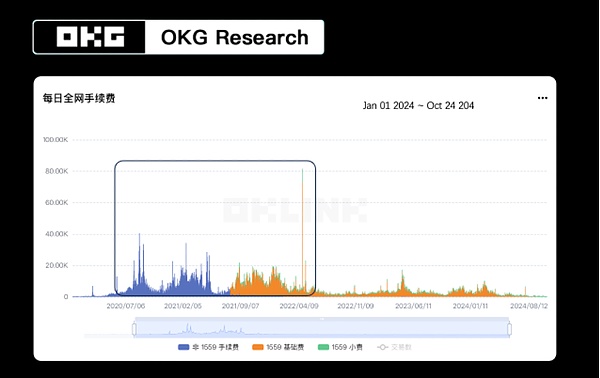
*OKG Research, Data source: Ethereum Gas Consumption from 200101~241024 from https://www.oklink.com/data/
Since the launch of two expansion schools around Ethereum, OP and ZK have all appeared, and the Ethereum main chain is used to ensure its own security. Judging from the current public chain data of several Layer2s, TPS has increased significantly, and L2 transaction fees have dropped significantly.

*OKG Research, Data Source: https://l2beat.com/scaling/activity
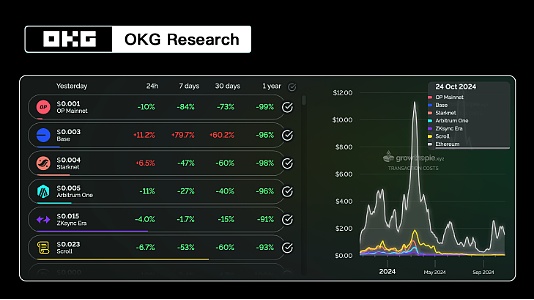
*OKG Research, Graph Source: https://www.growthepie.xyz/fundamentals/transaction-costs
However, the two mainstream expansion routes are moving, and have not really driven the large-scale growth of Ethereum users. From the perspective of daily active users, it has stabilized from 2021 to 2024.On the contrary, relying on L2 has also aggravated the further dispersion of liquidity and further separation of users in the Ethereum ecosystem.Some of the L2s have absorbed more ecological users with the support of specific tracks, and the competition with the main chain is becoming more and more obvious.
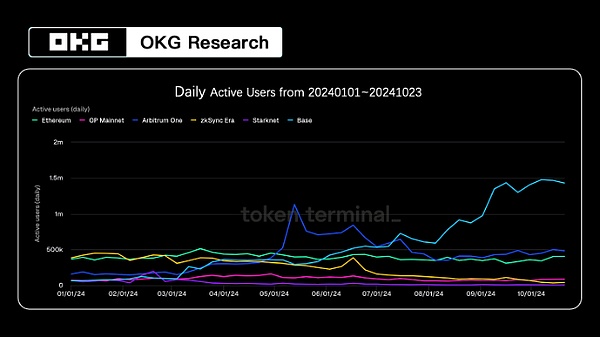
OKG Research, Data Source: https://tokenterminal.com/ Active Users from 240101~241031
Such competition has also aggravated the separation of interests between L2 and the main network. Before the deployment of EIP 4844, L2 needs to send transaction data permanently stored in the form of call data to the main chain, and it needs to pay high gas fees to Ethereum.This part accounts for about 70% to 80% of the entire L2 payment fee.After EIP 4844 is launched, transaction data only needs to be placed in the block carrying blob, and can be automatically deleted after a period of verification is completed, greatly reducing storage costs.
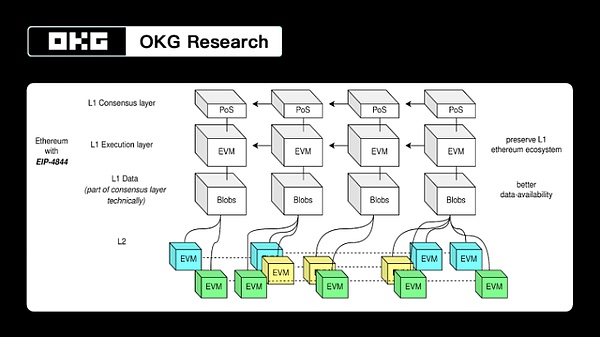
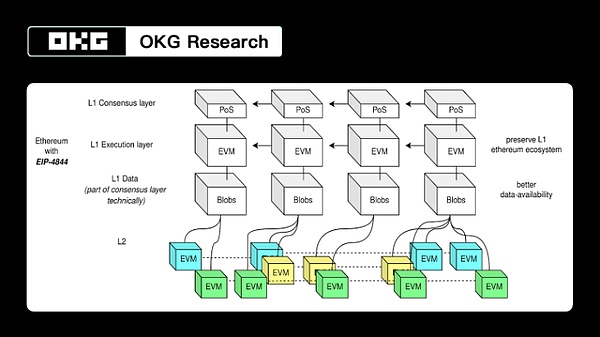
*OKG Research, Graph from https://hackmd.io/@luozhu/SyleCcpti
You can also find it from the chart of Rent Paid to L1The fees that L2 needs to pay to Ethereum show a significant downward trend, and at the same time, since L2 assumes the role of transaction execution, the income of MEV cannot be transmitted to the main chain, so the stakeholder’s rights of the main chain PoS will obviously be weakened by the reduction of fees.
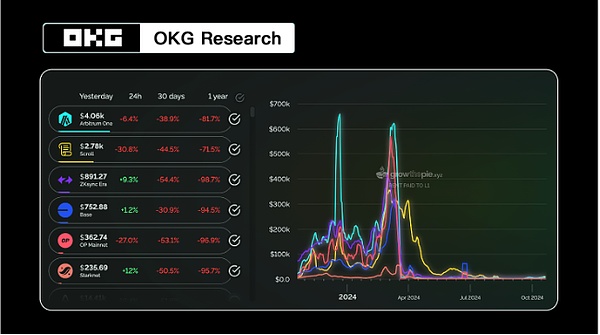
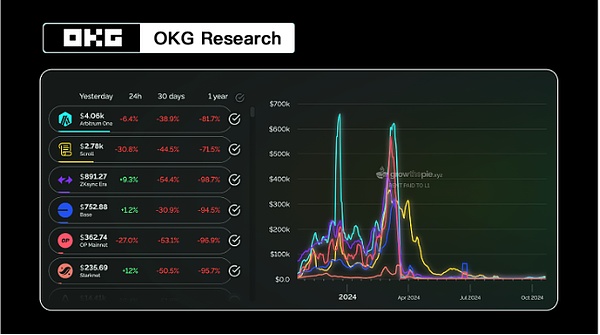
*OKG Research, Data Source: http://growthepie.xyz Rent Paid to L1
In addition, from the perspective of transaction finality, different types of L2 interoperability are very weak, and interactions often need to be implemented through the Ethereum main chain, which makes the frictional cost of user chain interactions remain high and the user experience is relatively limited.
This seems to have lost the original integrated vision of using L2 to achieve Ethereum expansion, and instead aggravates the separation between L2.Despite significant improvements in scalability and transaction fees, the liquidity of the L2 network is divided into multiple subnets, and the frictional cost of users transferring funds between each L2 is high.Various types of L2 need to copy and paste Ethereum’s existing narratives and applications, and lack a new track that can truly “break the circle”, which limits them to attract new user groups in their special applications.
The new public chain can avoid this situation in its own technical architecture design. Compared with the existing L2 solutions, the new L1 public chain can be better through a new consensus mechanism, modular design and optimization of user experience.Solve the performance bottlenecks currently facing public chains, such as Aptos, Sui, etc.
Through unique consensus algorithms and high-performance node networks, these Layer 1 public chains have improved not only the ability to show stronger scalability but also cheaper on-chain interaction costs, but also try to attract high cross-chain compatibility.Users scattered in different public chain ecosystems support more application scenarios.Especially for the support of consumer-level applications, try to integrate more diverse consumer-level application scenarios rather than just financial scenarios.These new features will help promote the popularization of blockchain technology and drive participation of more industries.
However, the new L1 requires rapid development of its own developer community and user base, which often requires a lot of marketing and incentives, increasing initial costs.They are also facing pressure to build a developer ecosystem and user community, and need to balance on-chain performance, decentralization and security levels. For example, downtime and crash stopping blocks are also engineering tests that need to be faced in stress tests.
With the competitive development of L2 and new L1 public chains, the expansion of the public chain ecosystem has accelerated, and users urgently need an aggregated “portal” to quickly access the Web3 network, but the previous description is not difficult to see the technical architecture adopted by different chains.It is also different, and requires a strong technical background to provide technical analysis and access services for different chains.
In the future, cross-chain migration and aggregation will become the norm in the blockchain industry, and users will be able to obtain better interactive experience and transaction security among more choices.
As an on-chain world constructed from data, multi-chain browsers are an important tool for industry participants to understand the on-chain world, which will require industry participants from different dimensions such as project parties, developers, and C-end users.However, the monetization method of general ecological browsers is limited, which depends to a certain extent on the support of the Ecological Foundation. The ecological site also determines that ordinary ecological browsers are often in a single-chain form. Ecological browsers can help users to penetrate vertically to a certain extentExplore, but with the increase in the number of public chains and the lack of a platform that can horizontally aggregate multi-chain data, it obviously cannot meet the needs of current users
Looking at the current multi-chain browser, the presentation form is more focused on separate display. Users cannot intelligently locate which public chain is on through simple address search, which results in the data on the chain being separated and cannot be aggregated through a unified platform.Related information.The friction cost of switching also requires users to synchronously manage account information distributed on each platform, and it is impossible to accurately aggregate discrete on-chain information.
At the same time, a highly modular technical architecture customized for the mainstream public chain ecosystem (EVM compatible chain, Cosmos ecosystem chain, UTXO, etc.); combined with user needs and market hotspots, more heterogeneous links that require customized are also urgently needed by users..However, considering the technical cost of public links, there is also a certain primary and secondary relationship between different on-chain data.
byOKX Web3 ExplorerThe aggregation multi-chain browser represented by the representative is trying to aggregate multi-chain information, combining its own positioning of common development with various ecology in the industry, and openly access to various types of public chains equally. Users can reach 50+ public chains through the same account and portal.Various types of data greatly reduce the burden on users in multi-chain information aggregation.
The integration entrance is also the best way to reach active users. By providing users with basic information on each chain, it can stimulate users’ curiosity to a certain extent, promote users to try to switch to a variety of public chain ecology, and promote the promotion of different ecological liquidity andThe integration of ecological applications.
In the long run,The trend of multi-chain integration will promote technological progress and application expansion in the blockchain industry, and promote the development of an open and collaborative ecosystem.This not only provides convenience for users to explore Web3, but also lays a solid foundation for a more open and inclusive on-chain world as a whole.








